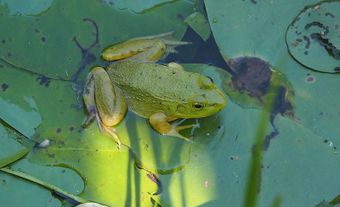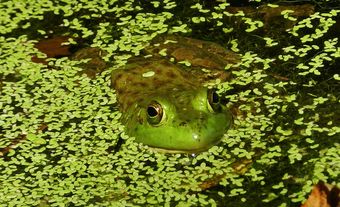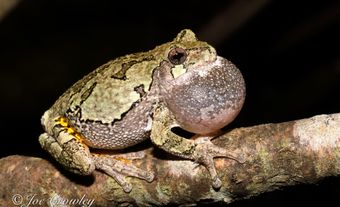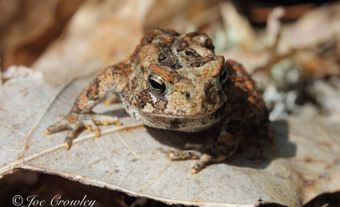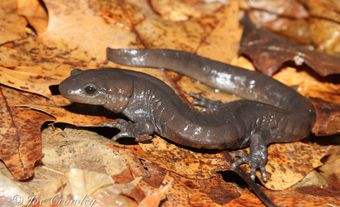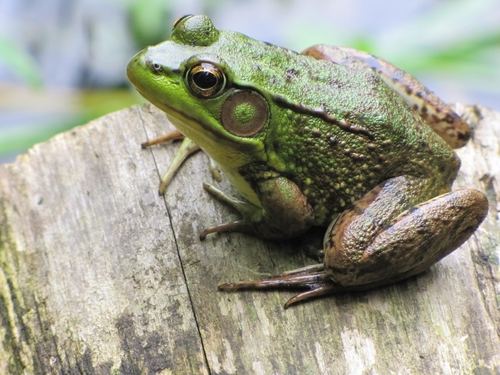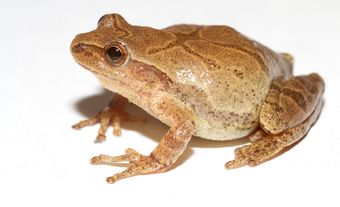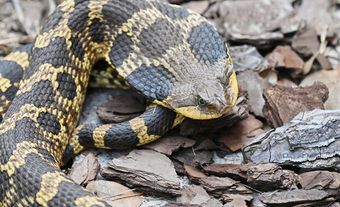The Northern leopard frog (Lithobates pipiens, previously Rana pipiens) is a green or brown frog covered in large, distinct spots. In Canada, three populations exist: the Eastern population, the Western Boreal/Prairie population and the Rocky Mountain population. The Committee on the Status of Endangered Wildlife in Canada characterizes the Western Boreal/Prairie and Rocky Mountain populations as special concern and endangered, respectively. The Eastern population is considered widespread and abundant, although the population has shown evidence of decline.

Description
Northern leopard frogs are medium-sized frogs that grow to between 5 and 11 cm in length. Females are generally larger than males. They are green or brown with white undersides. Large, rounded spots are present on their head, back, sides and legs. These spots are outlined with a lighter halo. They have two dorsolateral folds of skin, which are ridges that run from behind their eyes to their lower backs. These folds are tan to yellow and are generally a distinctive colour that contrasts with the surrounding skin. They also have a white line along their upper lip. Rare, unspotted individuals can be found in some parts of their range; these individuals are known as burnsi morphs.
The tadpoles of Northern leopard frogs are dark brown to dark green with gold speckles and bronze-coloured eyes. Their belly is cream coloured with some bronze iridescence. The tail fin is generally lighter than the body and may or may not have dark speckles.

Distribution and Range
The Eastern population of leopard frogs is found in the Atlantic provinces, Southern Quebec, most of Ontario, and Eastern Manitoba. The Western Boreal/Prairie population can be found in Western Manitoba, Saskatchewan, Southern Alberta and a small portion of the Northwest Territories. The Rocky Mountain population is exclusively found in a small area of Southeastern British Columbia.
In the United States, Northern leopard frogs can be found in the northern states east of the Rocky Mountains. They also exist in a few southern states, including Utah, Colorado, Arizona, New Mexico and a small part of Western Texas. Their historic range once extended west of the Rocky Mountains, but they have been largely extirpated from this area except for a few isolated populations.
In the summer, Northern leopard frogs can be found in woodland, prairie and tundra habitats. They prefer to forage for food in moist meadows and unwooded areas with grass that is less than 1 m tall. Breeding occurs in wetlands, ponds, lakes and slow-moving streams. These bodies of water may be temporary or permanent.
Northern leopard frogs overwinter at the bottom of oxygen-rich bodies of water which never freeze completely solid. These overwintering sites are usually different from breeding sites, and leopard frogs may travel as much as 1.6 km between them.

Reproduction and Development
The breeding season can begin as early as March and can continue until June, with later breeding seasons associated with the more northern parts of its range. The males call to attract females. The call of the Northern leopard frog sounds like a low snore followed by several grunts.
Females lay up to 7,000 eggs, although they are more likely to lay about half that number. As with most species of frog, males fertilize the eggs externally as they are laid by the female. The eggs are laid in a mass 6─15 cm in diameter and are usually attached to submerged vegetation or laid at the surface.
The eggs are black on top with white undersides and are surrounded by 2─3 jelly envelopes. Hatching occurs after approximately 1─3 weeks, with cooler temperatures resulting in later hatching.
Northern leopard frog tadpoles usually go through metamorphosis to turn into frogs in mid- to late summer. The speed of tadpole development is temperature-dependent, and in several locations, tadpoles have been documented as overwintering in permanent bodies of water. Frogs reach maturity after 1─3 years, with females generally taking longer than males. In the wild, they rarely live longer than 4─5 years, although their lifespan in captivity can be as long as 9 years.

Diet and Predators
Northern leopard frogs primarily eat insects, spiders and other small invertebrates. However, they can attempt to eat anything of the appropriate size that moves, and as such, will occasionally eat smaller leopard frogs and even small birds. As tadpoles, Northern leopard frogs eat aquatic plants, organic matter and scavenged meat.
Predators of adult leopard frogs include snakes, turtles, raccoons, birds, fish and other frogs. Tadpoles may be eaten by insects, birds, salamanders and fish.
Status and Threats
The Committee on the Status of Endangered Wildlife in Canada splits Northern leopard frogs into three different populations. Of these, the Rocky Mountain population is categorized as endangered, the Western Boreal/Prairie population as “special concern,” and the Eastern population as “not at risk.” The International Union for Conservation of Nature currently categorizes the Northern leopard frog as “least concern” and their population as declining.
Throughout its range, the Northern leopard frog is recognized as having been in decline since the 1970s. This decline has been particularly severe in the western parts of its range, where populations have been fragmented and extirpated in numerous locations. The primary threat to Northern leopard frogs is believed to be habitat loss and degradation. This includes habitat destruction, fragmentation and contamination by pollution. Increasing drought frequency and severity is also a risk to many populations. They are also threatened by predation, road mortality and diseases such as those caused by ranaviruses and chytrid fungi.

 Share on Facebook
Share on Facebook Share on X
Share on X Share by Email
Share by Email Share on Google Classroom
Share on Google Classroom

